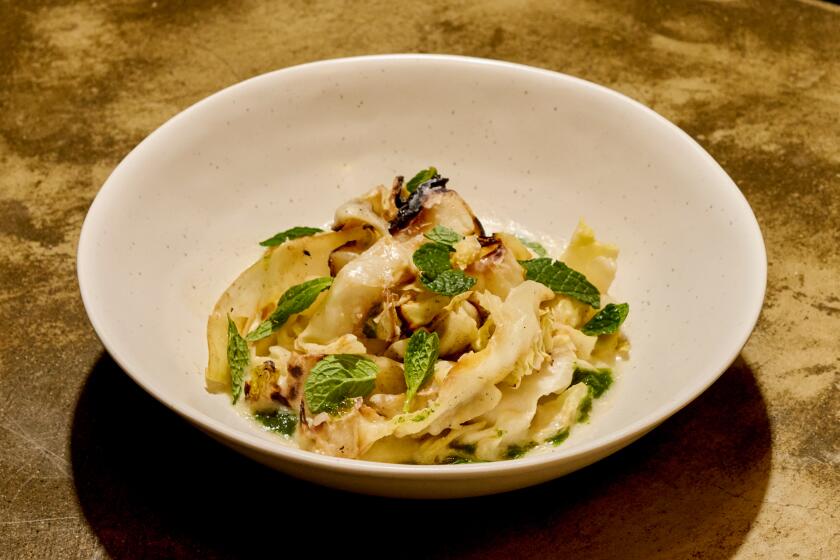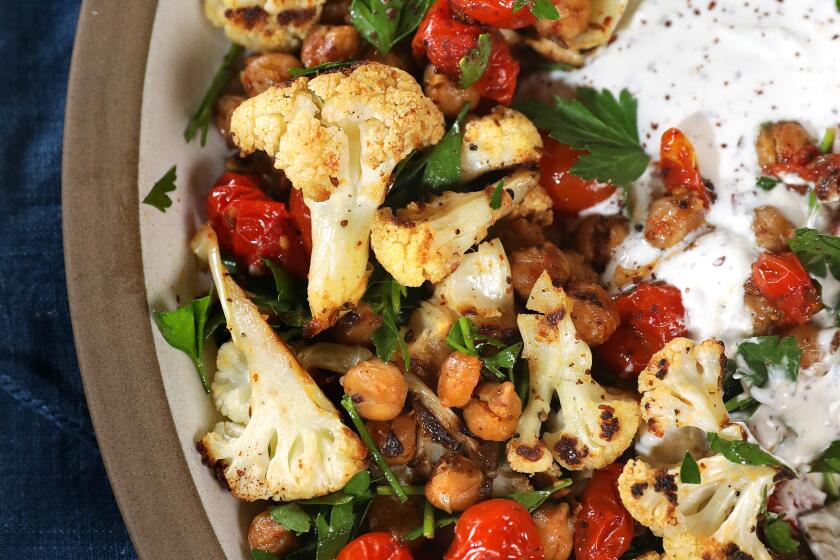Celery salad with pig ear, bacon and walnuts
It’s a different kind of cooking class Sasha Kanno and a half-dozen other students are taking this sunny Saturday morning in Long Beach. Standing around a portable worktable wheeled into a darkened nightclub, they are watching intently as Paul Buchanan, chef of Primal Alchemy catering company, goes to work. In front of him is a whole pig. It’s the size of a large dog and, after being cleaned and shaved, almost startlingly naked-looking. When Buchanan reaches for the hacksaw, rather than recoil, the students crowd in closer.
Though the scene may sound more reminiscent of a Hollywood slasher movie than Rachael Ray, there’s nothing macabre about it. This is no Halloween gross-out stunt. This class is just the tip of a very porky iceberg.
In part, it’s the latest step in the ever-advancing search for connection to where our food comes from.
“I’m all about a direct connection from farm to table and I want to take the next step into meat,” says Kanno, the tattooed, 33-year-old director of Long Beach’s Wrigley Community Garden.
“Some friends and I are trying to find a way we could bring in local meat. And if we do end up sharing a pig, we’re going to need to know how to break it down. “
At the same time, restaurant menus all over Southern California are featuring pig parts that were once considered untouchable. Of course, pork belly is everywhere; it has practically replaced foie gras on upscale menus. And there are Thomas Keller’s famous trotters on the menu at Bouchon in Beverly Hills. Downtown, you can find pig ears braised and then fried at both Church & State and at Lazy Ox. In the South Bay, Remi Lauvand sold out a whole pig menu at Manhattan Beach’s Cafe Pierre.
It’s not just the pros who are getting in on the game. Michael Ruhlman and Brian Polcyn’s “Charcuterie,” a do-it-yourself guide to making sausages and cured meats from scratch at home, has sold 60,000 copies.
The piggy passion has shown up in surprising places. On StyleForum, a men’s clothing website more familiar with debating the finer details of Savile Row bespoke suits, there is a long thread devoted to homemade sausage. Inspired, one member started his own copiously illustrated thread devoted to his recent vacation in the Dordogne region of France, spent helping out at a farmhouse pig slaughter and butchery.
What the heck is going on?
There is no single answer. Instead, there is a confluence of several strands that has elevated the pig back to its rightful place atop the food chain.
In the first place, of course, there is sheer deliciousness. Pork offers a variety of tastes and textures that no other animal can match. That for so long we have concentrated on only one cut (the loin -- the most expensive and least flavorful part of the pig, by the way) has been a shame.
Then there are cooks like Kanno and their search for connection. For the pros, there’s also a pride in craft -- working the whole pig, making the most of the so-called lesser cuts, takes real hands-on cooking.
There’s even a spiritual aspect to it. One of the tenets of nose-to-tail eating is that if you are going to kill an animal for food, you have a responsibility not to waste a single scrap.
And, of course, there’s a bit of marketing as well. Nothing pleases a certain kind of modern transgressive diner as much as seeing an obscure pig part or piece of offal on a menu. There’s a certain go-for-the-gusto bohemian quality to it. It is to today’s restaurant customer what copious amounts of garlic was to a previous generation.
“A good menu needs to have things everybody will enjoy, but it also needs to have one or two things that are kind of controversial, things everybody will talk about even if nobody much will eat them,” says Walter Manzke, until last week chef at Church & State.
Manzke says he’s been offering dishes like that since he started working for Joachim Splichal at Patina, back in the mid-1990s. “The difference is, people are actually ordering them now,” he says. “It’s about starting a conversation. Pig ears are a perfect example of that. It’s not something anybody is going to say ‘Oh, it tastes OK’ about. They are either absolutely disgusted by it, or absolutely in love with it. I think that’s great.”
Ruhlman says it was chefs who have led the way with his “Charcuterie” book, but that many others have followed. Even he is a bit astonished at its success.
“No one thought this book was going to do very well, given the state of cooking in this country,” he says. “I mean, let’s face it: Here’s a book devoted to animal fat and salt. Some of the recipes take days and even months to prepare, and if you don’t do it right, they can kill you. How are you going to sell that kind of book?
“But it took off. It’s been a big cookbook among guys and chefs. I was lucky in that it came out at a time when chefs were starting to return in a big way to their craft. And there’s no more craft-intensive area of cooking than charcuterie, so they really embraced it.”
Indeed, there’s a lot of hard-core sausage-making and meat-curing going on out there. Chad Colby, the chef at Mozza2Go, recently sent friends an e-mail with a string of pictures detailing his experiments breaking down a pig at the restaurant, including an absolutely lovely looking dish of lentils with zampone (an Italian sausage made from a whole stuffed pig’s foot).
Though finding whole pigs to cut up yourself still takes a bit of work, Southern California is a terrific place to explore the wide world of pig parts, thanks to the wealth of Asian and Latino groceries.
You can find just about any cut of pork you might want, from nose (stewed, it becomes deliciously gelatinous) to tails (braised, breadcrumbed and roasted, it’s profoundly porky) and anything in between. Even better, rather than paying $9 or $10 a pound for that dry, bland chop, almost all of these more interesting cuts are priced at $3 a pound or less.
Probably the surest first step would be to try pork belly, simply because there is no one who doesn’t like it. (If someone still seems a little squeamish, try the old trick of telling them it’s “fresh bacon.”)
Ever since “Charcuterie” came out, I’ve been tempted by a confit of pork belly based on a recipe by chef Jim Drohman.
Just think about it: little chunks of meltingly tender spiced pork belly stored in its own fat that you can pull from the fridge whenever you’re ready. Just a little browning in the skillet to crisp the surface and a tart green salad to cut the richness and you’re good to go.
The only problem was that Ruhlman’s recipe calls for 2 pounds of lard and oddly enough, given the number of other pork products available, I have yet to find a source for good lard. Not to worry, Ruhlman told me, the fat doesn’t make that much of a difference, use olive oil. I did, and he was right. And my refrigerator is now stocked.
That went so well, I decided to try something a little more out there. I really liked the pig ear salad that Church & State used to serve, so I talked the procedure out of Manzke. It’s simple, really: Braise the pig ears until they’re tender, chill them until they’re firm, and then slice them as thin as you can. Finish by tossing them into a skillet with nearly crisped bacon (Pig ears have great texture -- kind of soft and a little chewy with a crisp center -- but their flavor is subtle.)
In Manzke’s salad, the pig ears and bacon are served with frisee and poached eggs. I wanted to focus more on the texture of the ears, so I paired them with crisp, slightly bitter celery cut in matchsticks and dressed it with a tart, shallot-spiked vinaigrette before topping it with toasted walnuts.
It’s a terrific dish and even better, it leaves you with a really unctuous pork broth left over from braising the ears that will be perfect for cooking beans. Can you imagine a big pot of white beans cooked in a hearty pork broth and studded with chunks of crisped confit and little slivers of chewy ear?
On the other hand, in “The River Cottage Cookbook,” the British chef Hugh Fearnley-Whittingstall serves pig ears two ways: searing the whole pig ear in a cast-iron skillet and serving it like a steak, and rolling thinly sliced ears in mustard and bread crumbs and baking until they crisp.
Let’s face it, the pig is one generous animal, and we’ve only begun to explore its possibilities.
Braised pig ears
Warm the olive oil in a large skillet over medium heat and cook the carrots, celery and onion until soft, 8 to 10 minutes. Add the garlic and cook until fragrant, about 3 minutes.
While the vegetables are cooking, scrub the pig ears clean and cut away any knobby bits of cartilage so they will lay flat.
Place the pig ears in a single layer on top of the vegetables (they may overlap). Season with salt and add the water and dry white wine. Bring to a simmer, reduce the heat to low, cover and cook until the ears are very tender, about 3 1/2 hours.
Carefully remove the ears from the broth, place them on a parchment paper-lined plate, cover tightly with plastic wrap and refrigerate until firm, at least 2 hours. Save the flavorful broth for cooking beans. Once braised pig ears have been chilled, they can be tightly wrapped in plastic and frozen until ready to use.
Celery salad assembly
Cut the bacon crosswise into thin strips and cook in a skillet over medium heat. Cut the pig ear into similarly sized strips (cut the ear lengthwise into halves or thirds, then slice crosswise into thin strips). When the bacon is almost done, about 10 minutes, add the pig ear and cook, stirring frequently, until the bacon has finished browning, about 3 more minutes. Use a slotted spoon to remove the bacon and pig ear slices to a medium bowl, draining well and reserving the fat.
Carefully decant the fat from the skillet into a measuring cup, leaving the solids behind. Add enough oil to make one-half cup. Add the shallot, sherry vinegar, salt and parsley and whisk to combine.
Cut the celery into 1 1/2- to 2-inch matchsticks and place them in a large mixing bowl. Whisk the vinaigrette again to mix well and pour about 3 tablespoons of it over the celery -- just enough to moisten the celery without drowning it. Arrange the celery in a low mound on a serving platter.
Add the bacon and pig ear to the mixing bowl and add an additional 2 to 3 teaspoons of dressing, again, just enough to moisten. Scatter the bacon and pig ear over the celery. Scatter chopped walnuts over top and serve. This salad will hold at room temperature for about an hour without wilting.
Get our Cooking newsletter.
Your roundup of inspiring recipes and kitchen tricks.
You may occasionally receive promotional content from the Los Angeles Times.














